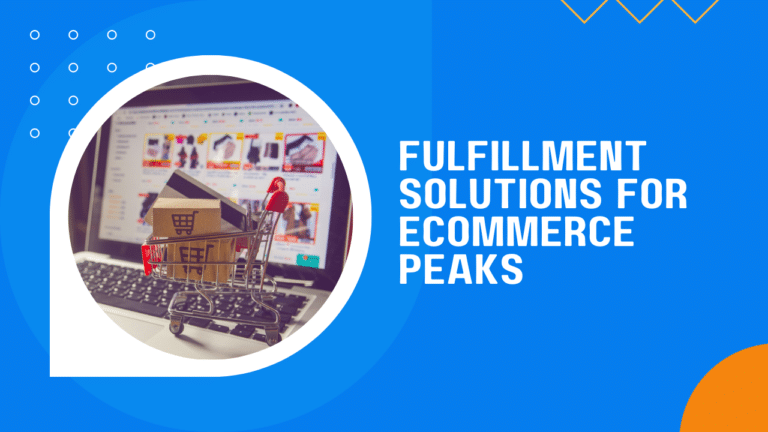The landscape of ecommerce is ever-evolving, and with it comes the challenge of managing peak sales periods. These high-demand times, such as Black Friday, Cyber Monday, and the bustling holiday season, present unique opportunities and hurdles for businesses in the digital marketplace.
At the heart of these challenges lies the critical aspect of order fulfillment – a pivotal factor in ensuring customer satisfaction and business success.
As online shopping surges during these peak periods, ecommerce businesses face the daunting task of scaling their operations to meet the exponential increase in orders. This surge not only tests the resilience of their inventory management systems but also puts their logistical capabilities to the test.
Efficient handling of this surge is not just about keeping up with the increased demand; it’s about transforming these high-pressure times into opportunities for growth and customer loyalty.
This article aims to shed light on effective strategies for managing these critical times, focusing on the nuances of inventory management, order processing, and the invaluable role of third-party logistics (3PL) partnerships.
Understanding Peak Periods in Ecommerce
Peak periods in ecommerce, such as Black Friday, Cyber Monday, and the holiday season, are more than just busy shopping days; they are pivotal moments that can define a business’s annual performance. These periods are characterized by a significant surge in consumer spending, driven by various sales events and promotions.
The allure of discounts and special offers during these times leads to a dramatic increase in online traffic and sales, making them crucial for ecommerce businesses.
The impact of these peak sales periods extends far beyond just increased revenue. They place immense pressure on every aspect of an ecommerce operation, particularly order volumes and logistics.
During these times, businesses often experience a manifold increase in orders, challenging their existing inventory and supply chain management systems.
This surge can lead to stock shortages, delayed shipments, and logistical bottlenecks, all of which can affect customer satisfaction and brand reputation.
Moreover, the logistics of handling such a high volume of orders are complex. It involves not only ensuring that inventory levels are sufficient to meet the demand but also that the entire supply chain is optimized for efficiency. This includes streamlining processes for receiving, processing, and shipping orders, as well as managing returns effectively.
The ability to handle these logistical challenges efficiently is critical for maintaining operational continuity and customer trust during these high-stakes periods.
Understanding these dynamics is essential for ecommerce businesses to prepare and strategize effectively for peak periods. Recognizing the patterns of consumer behavior, anticipating the surge in demand, and having robust systems in place to manage the increased load are key to turning these peak periods into successful sales events.
Preparing for the Surge
As ecommerce businesses brace for the inevitable surge in customer demand during peak periods, effective preparation becomes the linchpin of success. Inventory management and demand forecasting are critical components in this preparation phase, ensuring that businesses are well-equipped to handle the influx of orders without succumbing to stock outs or overstocking.
Effective inventory management for peak periods starts with accurate forecasting. By analyzing historical sales data, particularly from previous peak seasons, businesses can predict the likely demand for different products.
This data-driven approach allows for informed decisions on stock levels, ensuring that popular items are sufficiently stocked without overburdening storage with slow-moving products. Advanced forecasting tools can also factor in current market trends and consumer behavior, providing a more nuanced understanding of potential demand.
Once the forecasting is in place, the next step is to optimize inventory levels. This involves not only ensuring adequate stock but also organizing it in a way that facilitates quick and efficient order processing.
Streamlining warehouse operations, such as optimizing the layout for easy access to high-demand items and implementing effective stock rotation practices, can significantly reduce the time taken to process each order.
In addition to inventory management, preparing for the surge also involves strategizing for efficient order processing and fulfillment. This includes scaling up resources to handle the increased workload, such as hiring additional staff or extending working hours.
Automating certain processes, like order tracking and customer notifications, can also enhance efficiency and reduce the likelihood of errors.
Moreover, businesses should have contingency plans in place to handle unexpected challenges, such as sudden spikes in demand or supply chain disruptions. This could involve having backup suppliers, alternative shipping options, or flexible return policies to accommodate customer needs during these hectic periods.
By meticulously preparing for the surge in demand, ecommerce businesses can not only ensure smooth operations during peak periods but also capitalize on the opportunity to maximize sales and strengthen customer relationships.
Partnering with a 3PL for Peak Periods
Navigating the complexities of peak periods in ecommerce often requires more than just internal preparation; it calls for strategic partnerships that can extend a business’s capabilities. This is where the role of third-party logistics (3PL) providers becomes invaluable, particularly in managing the increased order volumes characteristic of peak sales times.
Third-party logistics providers specialize in the outsourced management of inventory, warehousing, fulfillment, and shipping services. By partnering with a 3PL, ecommerce businesses can leverage their expertise and infrastructure to efficiently handle the surge in orders.
This collaboration allows businesses to focus on their core competencies, such as product development and marketing, while the 3PL expertly manages the logistics.
One of the primary advantages of using a 3PL during peak periods is scalability. As order volumes fluctuate, a 3PL can adjust resources accordingly, ensuring that businesses can meet customer demand without the need for significant capital investment in warehousing and logistics. This flexibility is crucial for efficiently managing the ebb and flow of peak season sales.
Moreover, 3PLs bring a wealth of experience in logistics and supply chain management. They are equipped with the latest technology for inventory management, order processing, and shipping, which can significantly enhance the efficiency and accuracy of fulfillment processes. This technological edge is particularly beneficial during peak periods when the margin for error is slim, and customer expectations are high.
Maintaining Customer Satisfaction
During peak periods in ecommerce, the ability to maintain high levels of customer satisfaction is as crucial as managing inventory and fulfilling orders. These high-traffic seasons, while offering significant sales opportunities, also test the limits of customer service and delivery systems.
In this context, clear communication and the assurance of timely and accurate order delivery become pivotal elements in sustaining customer trust and loyalty.
Clear communication with customers during peak periods is not just about providing updates on shipping and delivery. It involves a proactive approach to managing customer expectations from the moment they browse your website to the post-purchase follow-up.
This includes transparent information about product availability, realistic delivery timelines, and prompt responses to customer inquiries. By setting accurate expectations and keeping customers informed at every step, businesses can significantly reduce confusion and frustration, which are common during busy shopping seasons.
Timely and accurate order delivery is another cornerstone of customer satisfaction. The joy of a great online shopping deal can quickly turn into disappointment with delayed or incorrect deliveries.
To prevent this, ecommerce businesses need to ensure their fulfillment processes are streamlined and error-free. This is where the efficiency of a well-organized logistics system, possibly managed by a 3PL like ShipBuddies, becomes evident.
By ensuring that orders are processed and shipped quickly and accurately, businesses can significantly enhance the customer experience.
Moreover, in the event of any issues or delays, a well thought out customer service strategy becomes essential. This includes having a responsive support team ready to address customer concerns and provide solutions.
Whether it’s a question about a product, a delay in shipment, or a return request, prompt and empathetic customer service can turn a potentially negative experience into a positive one, reinforcing customer trust.
Maintaining customer satisfaction during peak periods is a multifaceted challenge that requires a combination of clear communication, reliable fulfillment, and responsive customer service. By excelling in these areas, ecommerce businesses can not only survive the chaos of peak seasons but also thrive, building a loyal customer base that returns long after the holiday sales are over.
Navigating the High Tide: The ShipBuddies Advantage in Peak Periods
It’s clear that these times present both immense opportunities and formidable challenges for businesses. From the surge in order volumes to the complexities of logistics and customer satisfaction, managing these peak periods effectively is crucial for the success and growth of any ecommerce venture.
Understanding the dynamics of peak sales periods, such as Black Friday and the holiday season, is the first step in this process. Recognizing the impact on order volumes and logistics sets the stage for effective planning and execution.
Preparation is key, and this involves robust inventory management and forecasting. Implementing efficient order processing and fulfillment strategies ensures that businesses are not just surviving the surge but capitalizing on it.
This is where the role of a reliable third-party logistics provider becomes invaluable. A partner like ShipBuddies doesn’t just manage increased order volumes; it transforms the challenge into a seamless experience for both the business and its customers.
The final, and perhaps most critical, aspect is maintaining customer satisfaction. Clear communication and ensuring timely, accurate order delivery are the pillars of customer trust and loyalty. In the fast-paced and often unpredictable environment of peak periods, these elements become the lifeline of customer relationships.









